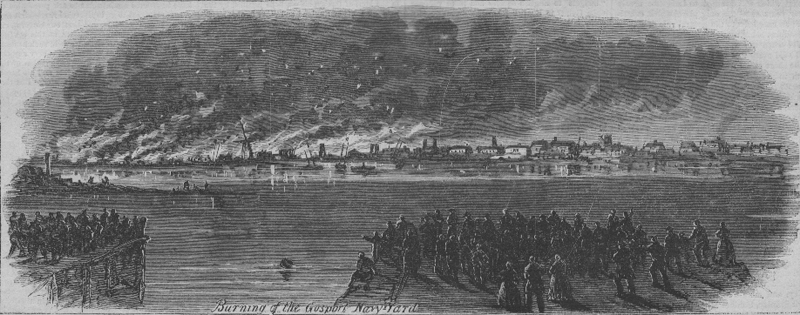
SURRENDER OF NORFOLK - MAY 10, 1862
PAGE 7
INVESTMENT OF THE CITY – THE NAVY YARD IN FLAMES.
NORFOLK, May 10, 7 P.M. – The national troops are now marching around and investing the city. It is getting dark, and there seems to be a busy stir among the crowd at the Gosport navy yard. Gen. Viele has dispatched a messenger to bring forward Col. Powell T. Wyman’s Sixteenth Massachusetts Regiment, for the purpose of throwing them across the river to occupy Portsmouth.
It seems but a few moments, when flames are seen bursting from a score or more of steamers, canal boats, schooners, barges, and other craft which the rebels have taken to the opposite shore in conveying their troops thither. In a few moments everything in the harbor is in a sheet of flame. The splendid steamers William Selden, Cayuga, Pilot Boy, Calypso, and many others whose names I could not obtain, were burning to the water’s edge. Now and then a hulk goes down, sending an immense volume of steam up from the bubbling surface. Here is a quandary. But the hardy seamen of the Union Coast guard quickly man a barge, and hastening to the river, seize a small flat steam ferry boat, and bring it to the wharf, apparently unobserved by the rebels on the other side.
Unfortunately, however, it will not bear more than one hundred men. Col. Wyman is on the alert, and in a few moments the boat is loaded. A Yankee engineer is put to work, and a soldier volunteers as pilot. She moves off quietly for the Portsmouth wharf; but just as she starts the flames burst forth from the buildings in the Gosport navy yard, and the town of Gosport is soon a mass of fire. The navy yard is destroyed; and even the Secessionists say that it is barbarous.
THE CREW OF THE FERRY BOAT LANDED.
The two iron-clad gunboats which the rebels had constructed are set on fire, but their decks only being of wood, but little damage is done them. The ferry- boat moves across the Elizabeth river, and one hundred brave men of the good old Bay State are landed at the Portsmouth wharf. They are received with friendly demonstrations by many ladies and gentlemen – one of the ladies bearing an American flag. They little expected this, in view of the destruction going forward.
They proceed to invest the town, and are soon reinforced to the extent of a battalion. Soon again a whole regiment is over. They move on. The rebels flee, taking with them all the rolling stock of the Petersburg Railroad – every car and every truck. Our troops move down the west bank of the river, and take possession of the palatial United States Marine Hospital, in which there are quite a number of sick and wounded rebels. No indignity is offered them. The surgeons of the regiments take the places of the rebel physicians, who have deserted their post at a time when most needed. Forward they go to the outskirts of the town, and thence to the fields, and, in the skirtings of woods, watch for the enemy. Weary and worn, some of them drop asleep, unconsciously, at their posts. Fortunately, no rebels are near. They have all slunk away in shame at their last act of vandalism.
ATTEMPT TO FIRE THE CITY.
But we must hie to the city with our little ferry-boat, lest the flames that envelope the vessels on the river prove contagious, and we lose our only transport. And now cones the last scene in this fiery drama. A canal boat all on fire is moving down with the tide, with its rudder strapped so as to make it bear directly to the city wharves, the design of the rebels being evidently to destroy the city, which they were compelled to abandon this morning. The boat, almost as correctly as if managed by a helmsman, bumps against the main wharf; and but for the promptitude of the contrabands in bringing a few unwieldy, old-fashioned hand engines to the scene, a fearful conflagration might have ensued. The fire is speedily extinguished, and the boat shoved out of the dock. It floats down the current a short distance, then sinks to rise no more.
Now the flames at the navy yard are dying away and we can see that the large ship-house and dry-dock are unharmed.
Surrender of Nofolk Continued
Back, page 1, page 2, page 3, page 4, page 5, page 6, page 7, page 8, page 9, page 10, page 11, Next
Source of Information
The Press, Philadelphia, PA Newspaper, Tuesday, May 13, 1862.
Image from Harper's Weekly May 24, 1862.
